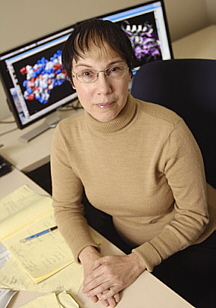
News Release
|
Office of News and Information Johns Hopkins University 901 South Bond Street, Suite 540 Baltimore, Maryland 21231 Phone: 443-287-9960 | Fax: 443-287-9920 |
EMBARGOED FOR RELEASE ON THURSDAY, FEB. 15, AT 8 PM EST CONTACT: Phil Sneiderman 443-287-9960 prs@jhu.edu |
Risky Gene Mutations
Mathematical Analysis Could Aid in
Predicting Cancer Cases
Certain cancer risks can be passed down through families, the result of tiny changes in a family's genetic code. But not all genetic changes are deadly. To help medical counselors and physicians identify the mutations that pose the greatest health risks, researchers at four institutions, including Johns Hopkins, have developed and validated a new computer tool.
The system, described in the Feb. 16 issue of Public Library of Science Computational Biology, evaluates 16 "predictive features" to help answer a critical question: Is a particular mutation a harmless variation or a genetic glitch that could set the stage for cancer? In blind biochemical tests involving 36 samples containing genetic mutations whose association with breast and ovarian cancer was unknown, the computer tool demonstrated an accuracy rate exceeding 94 percent in identifying protein functions that are believed to be linked to a higher risk of cancer.
The researchers cautioned that the computer tool by
itself cannot yet predict future cancer cases. But they
believe it can be a fast and useful supplement to
traditional biochemical tests, which are far more time-
consuming, costly and labor-intensive, and do not always
yield conclusive results.
 Rachel Karchin, a Johns Hopkins assistant professor of biomedical engineering, is using a computer tool to help identify genetic mutations that may lead to cancer. Photo by Will Kirk |
"When people are diagnosed with certain types of cancer, other family members sometimes get genetic testing to find out if they, too, are predisposed to this disease," said Rachel Karchin, an assistant professor of biomedical engineering at Johns Hopkins and lead author of the journal article. "But sometimes, the standard tests find small genetic variations that may be harmful or benign. Our computational test may help pinpoint which one it is. We hope the system will eventually give counselors and doctors an important new tool to help them advise patients about whether they need to take preventive steps to keep cancer from developing."
Karchin, who earned a doctorate in computer science from the University of California, Santa Cruz, joined Johns Hopkins last September as a participant in the university's Institute for Computational Medicine. "There are some things you can do with a computer that we hope will be useful in predicting the cancer risks associated with some genetic mutations," she said. "We're not quite there yet, but that's our goal."
Karchin began working on the new computer tool as a postdoctoral fellow in the lab of Andrej Sali, a professor of biopharmaceutical sciences and pharmaceutical chemistry at the University of California, San Francisco. For the current journal article, the biochemical tests to validate the computer tool were conducted in the lab of Alvaro Monteiro at the H. Lee Moffitt Cancer Center & Research Institute in Tampa, Fla. Sali and Monteiro are co-authors of the journal article.
In their experiments, the researchers focused on inherited mutations in the BRCA1 gene. A significant number of breast and ovarian cancer cases are believed to be caused by such mutations, possibly because they disable a gene that normally suppresses cancer.
To test the computer tool, Karchin and her colleagues used it to analyze 36 "point mutants" on the BRCA1 gene, meaning locations where a single letter in a string of DNA differed from the sequence found in the general population. This mutation caused an amino acid residue change in the protein produced by the gene. "Some of these types of variations can put a woman at greater risk for developing ovarian or breast cancer," Karchin said. "The question is: Which ones?"
To answer it, the researchers examined 16 factors in three categories. One category focused on whether the mutated genes produced proteins that performed their jobs properly. The second involved studies of the physical structure of the mutated gene. The third category was an assessment of the gene's evolutionary history, looking at how long the changed amino acid residue position has been preserved in various organisms. The last category is important because harmful mutations tend to be eliminated by evolutionary selection because of the damage they inflict on their carriers.
The researchers plugged these factors into a computer formula that identified the gene mutations most likely to be linked with cancer. Karchin was pleased that the system was highly successful at finding harmful mutations during the blind tests in Monteiro's lab. She believes it has a promising future. "Genetic counselors now base some of their advice on family history," she said. "But family histories are often incomplete. If we can give genetic counselors another tool, it could be very helpful to a lot of people."
The other co-authors of the journal paper were Sean V. Tavtigian of the International Agency for Research on Cancer in Lyon, France, and Marcelo A. Carvalho of the Moffitt Cancer Center. The research was supported by grants from the National Institutes of Health
Digital color photo of Rachel Karchin available; contact Phil Sneiderman.
Related Links
Rachel Karchin's Lab Page
Institute for Computational Medicine at Johns
Hopkins
Johns Hopkins Department of Biomedical Engineering
|
Johns Hopkins University news releases can be found on the
World Wide Web at
http://www.jhu.edu/news_info/news/ Information on automatic e-mail delivery of science and medical news releases is available at the same address.
|
 Go to
Headlines@HopkinsHome Page
Go to
Headlines@HopkinsHome Page